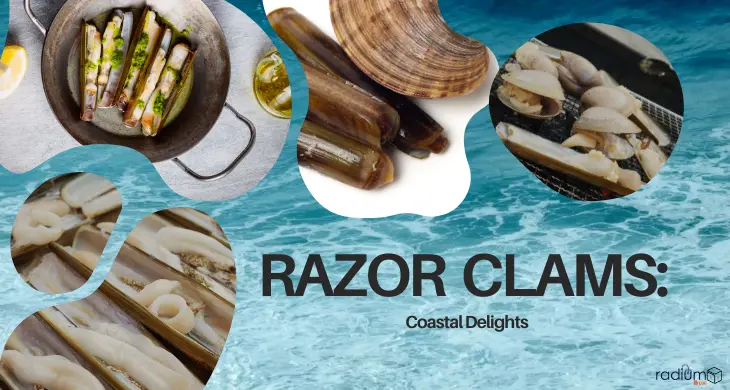The coastal regions of the world are teeming with culinary treasures, and one such delight that often remains hidden beneath the sands is the razor clam. This elongated shellfish, with its sleek and narrow shell, is a coastal delicacy that has been cherished by seafood enthusiasts for generations. In this detailed blog, we’ll embark on a journey to discover the world of razor clams – from their intriguing biology to the mouthwatering dishes they inspire.
What are Razor Clams?
Razor clams are a type of edible shellfish characterized by their long, narrow, and sleek shells. These bivalve mollusks belong to the Ensis genus and are known for their unique appearance and delicious meat. They are often found in coastal regions, primarily inhabiting sandy shorelines where they burrow into the substrate for protection and to filter food from the surrounding waters.
The name “razor clam” is derived from the clam’s elongated, razor-like shell, which can grow up to several inches in length. The shells of razor clams are typically dark and glossy, and they are prized for their soft, tender, and flavorful meat.
Razor clams have a sweet and briny flavor, making them a popular choice for seafood enthusiasts. They are used in various culinary preparations, from chowders and pasta dishes to grilled and fried recipes. Due to their unique shape and flavorful meat, razor clams have become a sought-after delicacy in many coastal cuisines.
Harvesting razor clams often involves using specialized tools to carefully dig them out of the sandy shores, as they are known for their quick burrowing ability. It’s important to follow local regulations and guidelines to ensure sustainable harvesting practices and protect the clam population.
Razor clams can be found in different parts of the world, contributing to various culinary traditions. The specific species and culinary practices associated with razor clams may vary by region, but their delectable taste and versatility in the kitchen are celebrated by seafood lovers around the globe.
Anatomy and Habitat:
Razor clams are fascinating creatures with distinctive anatomical features and specific habitat preferences that allow them to thrive along coastal shorelines. Here, we delve into their anatomy and preferred environments:
1. Shell:
- Razor clams are characterized by their elongated, narrow shells, which resemble a straight razor blade, hence their name.
- These shells can grow to several inches in length, providing a protective covering for the clam’s soft, edible body.
2. Body:
- The soft body of a razor clam is housed within its long, slender shell.
- The meat of the razor clam is highly prized for its sweet, briny flavor and tender texture.
3. Muscular Foot:
- Razor clams possess a muscular foot, which is a prominent part of their anatomy.
- This muscular foot is used for digging into the sandy substrate and allows the clam to burrow rapidly to evade predators or seek refuge from crashing waves.
4. Burrowing Habit:
- These clams are known for their exceptional burrowing skills, which are facilitated by their muscular feet.
- Razor clams use their feet to dig into the sandy shoreline, effectively disappearing beneath the sand, where they are well-protected from potential threats.
5. Preferred Habitat:
- Razor clams primarily inhabit sandy shorelines along coastal areas.
- They are often found in intertidal zones, where the sand meets the water.
- These clams prefer to live in sandy substrates, as the loose sand allows for easier burrowing and provides them with protection and camouflage.
6. Foraging and Feeding:
- Razor clams are filter feeders, meaning they extract plankton and other tiny food particles from the water.
- They extend their siphons, which are tube-like structures, up to the surface of the sand to filter food as the tide washes over them.
Culinary Appeal:
Razor clams, with their intriguing appearance and delectable meat, hold a special place in the world of culinary delights. Here, we explore their culinary appeal and how these shellfish have become a sought-after ingredient in various culinary traditions:
1. Unique Appearance:
- Razor clams are instantly recognizable due to their long, sleek shells that resemble straight razor blades.
- Their distinctive appearance adds an element of intrigue to dishes in which they are featured.
2. Delicate Flavor:
- The meat of razor clams is celebrated for its exceptional flavor. It boasts a delightful combination of sweetness and brininess that appeals to seafood enthusiasts.
- This delicate flavor profile allows razor clams to be used in a wide range of culinary preparations.
3. Versatility:
- Razor clams are incredibly versatile in the kitchen, making them a favorite among chefs & home cooks.
- They can be used in various dishes, including chowders, pastas, stir-fries & grilled or fried recipes.
4. Culinary Creativity:
- Chefs often appreciate the unique shape and appearance of razor clams as they provide opportunities for culinary creativity and artistic plating.
- Razor clams can be the star ingredient in visually stunning and delicious seafood dishes.
5. Regional Specialties:
- Different coastal regions have their own culinary specialties featuring razor clams. For example, razor clam chowder is a beloved dish in the Pacific Northwest of the United States.
- These regional variations showcase the adaptability of razor clams in diverse culinary traditions.
6. Nutritional Value:
- Razor clams are not only flavorful but also nutritious. They are a good source of lean protein and essential nutrients, making them a healthy addition to meals.
7. Sought-After Delicacy:
- Due to their unique flavor and culinary adaptability, razor clams have earned a reputation as a sought-after delicacy, both in fine dining establishments and among seafood connoisseurs.
Whether enjoyed in a comforting clam chowder, a seafood pasta, or a gourmet seafood platter, razor clams offer a culinary experience that combines their unique appearance with their exquisite taste. Their versatility in the kitchen and their ability to elevate a wide range of dishes make them a beloved ingredient for those who appreciate the pleasures of seafood cuisine.
Harvesting and Sustainability:
The process of harvesting razor clams is a delicate balance between meeting culinary demand and ensuring the long-term sustainability of these unique shellfish. Here, we delve into the harvesting methods and the sustainability efforts associated with razor clams:
1. Hand Harvesting:
- Razor clams are often hand-harvested, especially in areas where they are abundant and regulations allow for this method.
- Harvesters use specialized tools like clam guns or cylindrical tubes to extract the clams from the sandy substrate.
2. Tidal Zones:
- Razor clams are typically found in intertidal zones, where the sandy shoreline meets the water. Harvesting often takes place during low tide when the clams are closer to the surface and accessible.
3. Regulations and Seasons:
- Many coastal regions implement strict regulations and seasonal restrictions on razor clam harvesting to prevent overfishing and protect the clam population.
- These regulations often include size limits and limits on the number of clams that can be harvested per person.
4. Sustainable Practices:
- Sustainable harvesting practices are essential to ensure the long-term health of razor clam populations.
- Efforts are made to minimize the impact on the clam habitat and prevent habitat degradation during harvesting.
5. Environmental Impact:
- Sustainable harvesting takes into consideration the potential environmental impact of clam digging, such as disruption of beach ecosystems.
- Guidelines are established to minimize any adverse effects on coastal environments.
Razor Clams Worldwide:
Razor clams, known for their unique appearance and culinary appeal, can be found in various coastal regions around the world. They are not limited to a single locale but have a global presence, each with its own species and distinct characteristics. Let’s take a journey to explore razor clams worldwide:
1. Pacific Razor Clams (Siliqua spp.):
- Found in: The Pacific razor clam is a group of species primarily found along the west coast of North America, from California to Alaska.
- Distinctive Traits: These razor clams are known for their long, straight, and slender shells, resembling a straight razor blade. They are highly sought after for their sweet and briny meat, often used in dishes like chowder.
2. Atlantic Razor Clams (Ensis spp.):
- Found in: Atlantic razor clams can be found along the eastern coasts of North America and Europe, including regions such as the Eastern United States and the United Kingdom.
- Distinctive Traits: Atlantic razor clams have long, narrow shells and are known for their delicate, sweet flavor. They are used in various seafood dishes, particularly in European cuisine.
3. Japanese Razor Clams (Tapes philippinarum):
- Found in: The Japanese razor clam is native to the coastal regions of Japan and can also be found in other Asian countries.
- Distinctive Traits: These clams are a popular seafood ingredient in Asian cuisine, prized for their tender meat.
4. Razor Clams of New Zealand (Ensis directus):
- Found in: Razor clams in New Zealand, including the Tua Tua clam, are found along the country’s coastal areas.
- Distinctive Traits: These clams are appreciated for their unique taste and are used in various seafood preparations, including fritters and chowders.
5. European Razor Clams (Ensis spp.):
- Found in: European razor clams are common in the coastal regions of Europe, including the shores of the Mediterranean Sea.
- Distinctive Traits: These clams are cherished for their delightful flavor and are featured in Mediterranean and European cuisine.
6. Razor Clams of Chile (Ensis macha):
- Found in: Ensis macha, a species of razor clam, is native to the coastal areas of Chile in South America.
- Distinctive Traits: These clams are enjoyed in Chilean cuisine, often prepared in traditional dishes like “machas a la parmesana.”
7. African Razor Clams (Ensis spp.):
- Found in: Various species of razor clams can be found along the coastal regions of Africa, offering a local seafood source.
- Distinctive Traits: These clams contribute to African coastal cuisine, adding their unique flavor to regional dishes.
The Pleasure of Razor Clams:
Their exquisite taste and versatility in the kitchen make them a true pleasure to savor. Let’s dive into the world of razor clams and discover the joy they bring:
1. Culinary Versatility: Razor clams are a prized ingredient in the culinary world, thanks to their sweet and delicate flavor. They can be prepared in various ways, from simple and classic recipes to innovative and gourmet dishes. Whether you enjoy them steamed, fried, grilled, or in a creamy chowder, razor clams offer a world of culinary possibilities.
2. Distinctive Flavor: The unique taste of razor clams sets them apart from other shellfish. Their tender and slightly briny meat carries a hint of sweetness, making them a sought-after delicacy. The flavor profile of razor clams appeals to seafood lovers and adds a touch of luxury to any meal.
3. Coastal Connection: For those living near coastal regions, razor clams represent a connection to the sea and a link to maritime traditions. Razor clam digging, a popular activity in some areas, brings people closer to nature and the thrill of foraging for their food along the sandy shores.
4. Culinary Creativity: Chefs and home cooks alike appreciate the creative possibilities razor clams offer. Their elegant, elongated shells and tender interiors inspire culinary experimentation. From elegant seafood platters to innovative seafood fusion, razor clams provide a canvas for culinary artistry.
5. Shared Experiences: Enjoying a meal featuring razor clams can be a shared experience, bringing friends and family together around the dining table. Whether it’s a seaside picnic, a beachside barbecue, or a cozy dinner at home, razor clams create memorable moments.
6. International Delicacy: Razor clams have a global presence, and their popularity extends beyond borders. They grace the tables of seafood restaurants worldwide, showcasing their versatility in various cuisines.
7. Culinary Heritage: In some regions, razor clams are an integral part of culinary heritage. They’ve been part of traditional dishes for centuries, passed down through generations, preserving the culinary traditions of coastal communities.
Frequently Asked Questions:
1. What are razor clams, and why are they called “razor” clams?
Razor clams are a type of shellfish found in sandy coastal areas. They are named for their long, narrow, and razor-sharp shells, which resemble old-fashioned straight razors. These shells help them burrow into the sand.
2. Where can you find razor clams, and are they available year-round?
Razor clams are primarily found in coastal regions with sandy shores. They are commonly harvested in places like the Pacific Northwest in the United States and various European coastlines. The availability of razor clams can vary by location, but they are generally available year-round, with some seasonal fluctuations.
3. How are razor clams harvested?
Razor clams are often harvested by digging in the sand where they are buried. This can be done using a clam gun, shovel, or even by hand. Harvesting regulations and methods may differ depending on the region, so it’s essential to follow local guidelines and obtain the necessary permits.
4. What do razor clams taste like, and how can they be prepared?
Razor clams have a sweet, delicate flavor with a hint of brininess. They are versatile and can be prepared in various ways, including steaming, frying, grilling, or incorporating them into chowders and pasta dishes. Their unique taste pairs well with a variety of flavors.
5. Are razor clams sustainable to consume?
Sustainable harvesting practices are crucial to the long-term viability of razor clam populations. Many regions have strict regulations to ensure sustainability. It’s essential to follow local guidelines and support responsible seafood sourcing.
Conclusion:
The world of razor clams is a fascinating realm where coastal treasures meet culinary delights. These slender shellfish, named for their razor-sharp shells, offer a unique taste of the sea with their sweet and briny flavor. Whether harvested on sandy shores or savored in seafood restaurants, razor clams have a special place in the hearts of coastal communities and seafood enthusiasts.The appeal of razor clams extends beyond their flavor. Their sustainable harvesting practices ensure that future generations can continue to enjoy these coastal delights. Recreational clam digging adds an adventurous twist to the experience, allowing individuals to connect with the natural world while sourcing their own seafood.
Razor clams have earned their place in various global cuisines, from the “Navajas a la Plancha” of Spain to the clam chowders and pasta dishes of the Pacific Northwest in the United States. Their versatility in the kitchen means that there are countless ways to savor their unique taste.




